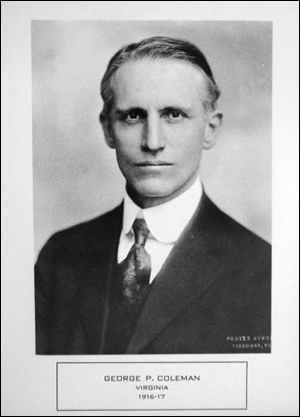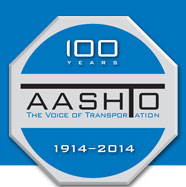
July 16, 2014
AASHTO Presidential Profile: George P. Coleman of Virginia

George Preston Coleman, chairman of Virginia’s state highway commission, served as the second president of the American Association of State Highway and Transportation Officials (AASHO) during a time filled with challenges and changes for both the nascent organization and the development of roads nationwide. It was also a time in which the U.S. found itself entering into and helping to fight World War I.
Coleman was born on May 4, 1870 in Williamsburg, Virginia. He came from a family of high-profile lawyers, professors, and public officials. Coleman’s Bermuda-born great-grandfather St. George Tucker, for example, was a renowned professor of law at the College of William and Mary in Williamsburg in the late 18th and early 19th centuries and a judge whose experience included serving on the U.S. District Court for the District of Virginia.
After studying at the College of William and Mary, Coleman went on to work as an engineer in Mississippi, Georgia, West Virginia, and Minnesota. He served as city engineer of Winona, Minnesota, from 1901 to 1906.
In 1906, Coleman returned to his home state to serve as assistant highway commissioner. He served under P. St. Julian Wilson, that entity’s first chairman, and the others on the staff included a chief clerk, stenographer, and draftsman.
Coleman took over as commission chairman in 1911 and would work hard to further enhance and expand Virginia’s roads network. “The State Highway Commission of Virginia was formed just ten years ago, and constructed during the first two years some twenty-two miles of improved road,” he noted in a report in 1916. “Since that time, however, the work of the department has increased by leaps and bounds.” As he went on to document, Virginia’s state system of highways had grown to 3,762 miles by 1915 and was expected to add another 800 miles in 1916 alone.
Even as he sought to strengthen the reach and reliability of roads in Virginia, Coleman also assumed a major leadership role when it came to highway priorities at the national level. He developed an early and powerful sense that there was a need for a group of state engineers to help address the ever-growing importance of highways across the United States.
Coleman’s advocacy efforts gained more traction by the time 1914 arrived. In a letter sent in January of that year to various colleagues, Coleman promoted the idea of a stand-alone association of state highway engineers for “their mutual benefit and to advance the road interests.” He further wrote, “If a sufficient number of all of us attend this meeting in Atlantic City next month we could do this, or arrange for a later meeting in Atlanta in the fall.” That initial meeting ended up taking place in Atlanta that November during a convention of the American Highway Association. Coleman was among those state engineers in attendance who issued a call for all of their colleagues to convene the following month in Washington, D.C.
As one of the founders of AASHO at that D.C. meeting in December 1914, Coleman was a member of the nominating committee that selected Henry G. Shirley as the association’s first president and also chose the other new officers. “I . . . did a rather unusual thing and suggested that the nominating committee was among themselves as the executive committee, which was done,” Coleman later recounted. “The nominations as presented by the nominating committee went through without opposition.” Coleman was also among those in the newly formed association who journeyed to the White House later that day to meet with President Woodrow Wilson.
After Shirley had served two terms as AASHO president, Coleman succeeded him in that role in late 1916. Coleman’s tenure focused on further nurturing the new organization and in particular maintaining the momentum of the federal-state partnership in highways development that had been ignited by the Federal Aid Road Act of 1916; it was during his time as president that the first state project submitted under that landmark law – a 2.55-mile stretch of road between Albany and Richmond in California – was completed.
In addition, Coleman’s year as AASHO president took place when the U.S. joined the Allied Powers in fighting World War I. Coleman highlighted the military necessity of highways domestically during that global conflict, explaining in July 1917 that roads “are of the greatest importance for the mobilization of armies in times of war.”
He also looked beyond the war itself to emphasize the continuing importance of a viable highways network. At the AASHO Annual Meeting in Richmond, Virginia, in December 1917, for example, he said that roads “enable us to carry on the war to a successful issue and at the same time prepare our country for peace and enable us to develop our resources, protect our commerce, extend our interests, and take our proper place in rebuilding a world which has been devastated by the forces of war.”
After stepping down as AASHO president, Coleman continued serving on the association’s Executive Committee for a few more years. Coleman’s tenure as Virginia state highway commission chairman officially came to an end in 1923, when – in a reversal of the order in which they serve as AASHO presidents – he was succeeded by Shirley in that role.
Coleman continued to remain active in public life. He took a leading role in the efforts to restore Williamsburg to the way it had appeared back in colonial times, and served from 1929 to 1934 as that city’s mayor. In addition, Coleman became president of the Virginia-based Peninsula Bank and Trust Company in 1927.
Coleman died at this home in Williamsburg on June 17, 1948, at the age of 78. In reporting on his death, AASHO’s American Highways magazine noted his continued enthusiasm for roads that extended well beyond his years as a founder of the association and one of its earliest presidents. According to that article, “Mr. Coleman always maintained an active interest in highway affairs and the [AASHO] office was frequently the recipient of his informative and welcome letters on highway matters.”












